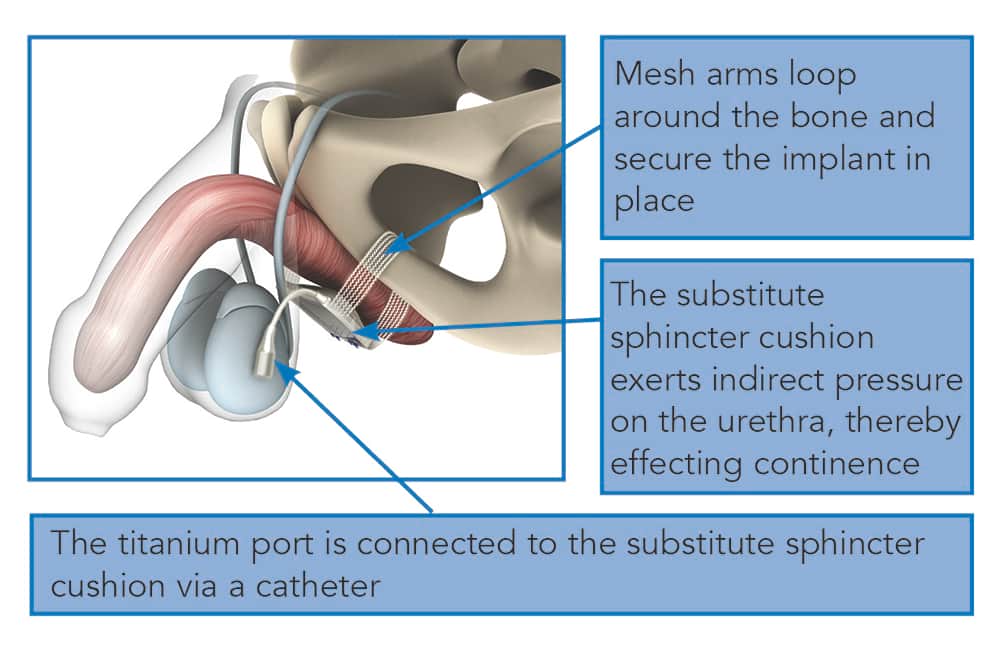What is an atoms device for urinary incontinence in men?

Occasionally men can develop urinary incontinence (involuntary leakage) after prostate surgery due to weakness of the urinary sphincter muscle. Mild to severe male urinary incontinence can be treated by inserting an ATOMS (Adjustable Transobturator Male Sling) device which comprises of an adjustable silicone cushion which is held against the urethra by a mesh sling which passes around the pelvic bone (see picture). The silicone cushion is filled with saline through a port to gently compress the urethra and restore continence. Studies indicate that urinary incontinence significantly improves in 80-90% of men after insertion of an ATOMS device.
What are the alternatives to this procedure?
Alternatives to this procedure include incontinence into a pad, a permanent catheter, or insertion of an artificial urinary sphincter device or another type of sling.
What should I expect before the procedure?
You will usually be admitted to hospital on the same day as your surgery.
You will be asked not to eat and drink for six hours before surgery.
Immediately before the operation, the anaesthetist may give you a pre-medication, which will make you dry-mouthed and pleasantly sleepy.
You will be fitted with elasticated stockings to prevent venous thrombosis (clots in your legs).
Please inform your surgeon (before your surgery) if you have any of the following:
- An artificial heart valve.
- A coronary artery stent.
- A heart pacemaker or defibrillator.
- An artificial joint.
- An artificial blood-vessel graft.
- A neurosurgical shunt.
- Any other implanted foreign body.
- A regular prescription for a blood thinner e.g. Warfarin, Coumadin Xarelto®, Pradaxa®, Clopidogrel (Plavix®), Brilinta®, or Aspirin.
- Previous or current infection with an antibiotic resistant organism such as MRSA, VRE, etc.
What happens during the procedure?
A full general anaesthetic is normally used and you will be asleep throughout the procedure. You will usually be given an injection of antibiotics before the procedure, after you have been checked for any allergies. The anaesthetist may also use an epidural or spinal anaesthetic to reduce the level of pain afterwards.
The surgeon will make a small incision in the area between the scrotum and the anus (perineum) to expose the urethra and the muscle covering it. The silicone cushion is placed up against the urethra and a small mesh tape is passed around the pelvic bone to anchor the cushion in place. A port for filling the cushion is then positioned under the skin of the scrotum where it is easily felt. The skin incision is closed with dissolving sutures. The cushion is then filled through the port until adequate compression of the urethra is observed using a cystoscope (telescope). A catheter is then placed in the bladder.
What happens immediately after the procedure?
You will be given fluids to drink at an early stage after the operation. You will be encouraged to mobilise as soon as you are comfortable to prevent blood clots forming in your legs and you will be given intravenous antibiotics. Your catheter will normally be removed before you go home. The average hospital stay is one day.
Are there any side-effects?
Most procedures are straightforward; however as with any surgical procedure there is a chance of side effects or complications.
Common (greater than 1 in 10)
- Temporary mild to moderate perineal or pelvic pain which usually resolves after 3-4 weeks.
Occasional (between 1 in 10 and 1 in 50)
- Urinary retention (inability to pass urine) requiring reinsertion of a catheter and/or adjustment of the sling.
- Failure to improve continence despite adjustment of the sling.
- Numbness of the head of the penis which usually resolves after a 3-4 weeks
Rare (less than 1 in 50)
- Erosion of the sling into the urethra or through the skin incision which will require the sling to be surgically removed.
- Infection of the sling or bone which will require surgery to remove the sling.
- Movement of the sling away from its ideal position which may cause it to stop working.
What should I expect when I get home?
Pain
Your discomfort should disappear gradually over a few days although you may continue to feel tired for at least 10 to 14 days. Mild painkillers such as Paracetamol should be enough to deal with any pain. Some men do experience mild to moderate perineal pain for around 3-4 weeks.
Bowels
It is important that you do not get constipated. There are no dietary restrictions but you should try and eat plenty of fruit and vegetables and wholemeal bread. If you feel that you may be constipated, see your GP.
Exercise
You should take it easy for 3-4 weeks, although it is important to take some gentle exercise like walking, as you will be at a slight risk of developing a blood clot in your legs if you do not keep mobile.
It is safe to resume normal sexual activity 2 weeks after your surgery.
What else should I look out for?
If you develop a fever, severe pain on passing urine, inability to pass urine or worsening bleeding, you should contact your Surgeon immediately. If out of hours, please go to your nearest emergency department.
Disclaimer
This information is intended as a general educational guide and may not apply to your situation. You must not rely on this information as an alternative to consultation with your urologist or other health professional.
Not all potential complications are listed, and you must talk to your urologist about the complications specific to your situation.
